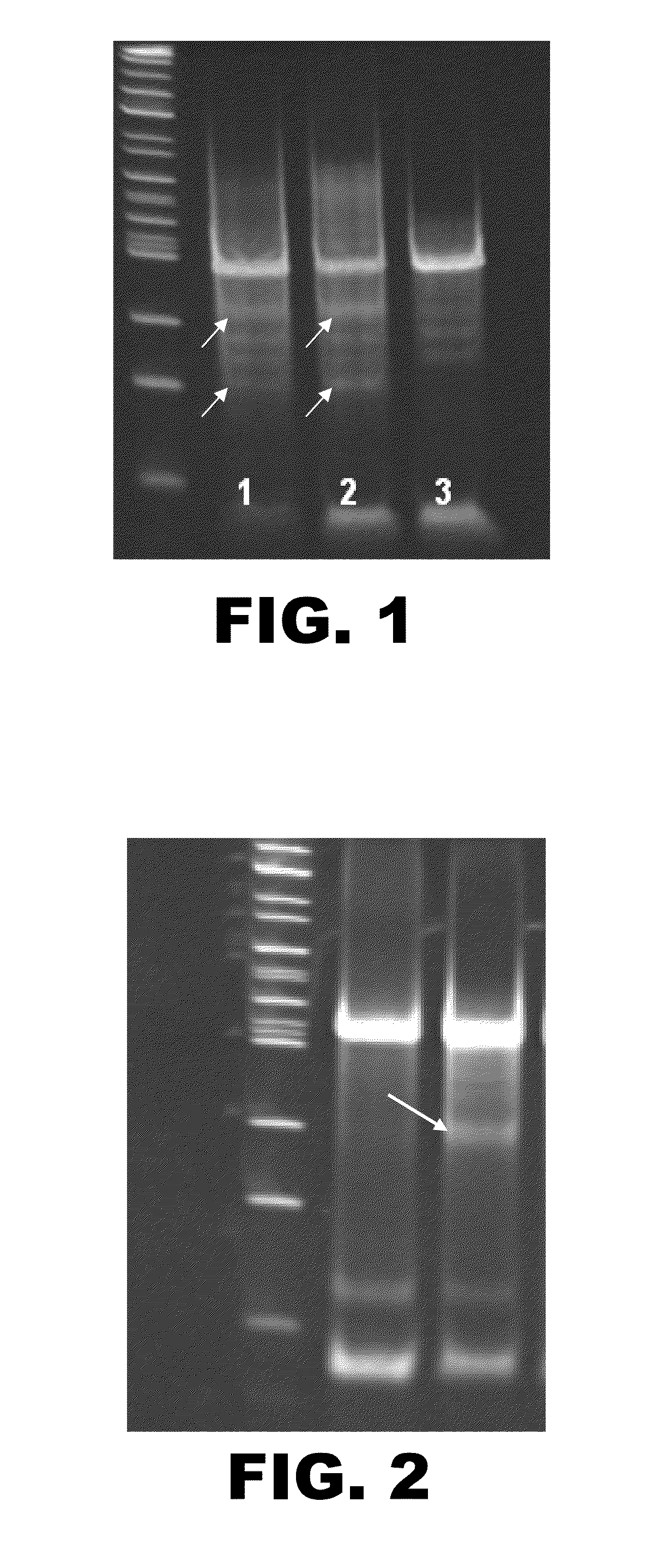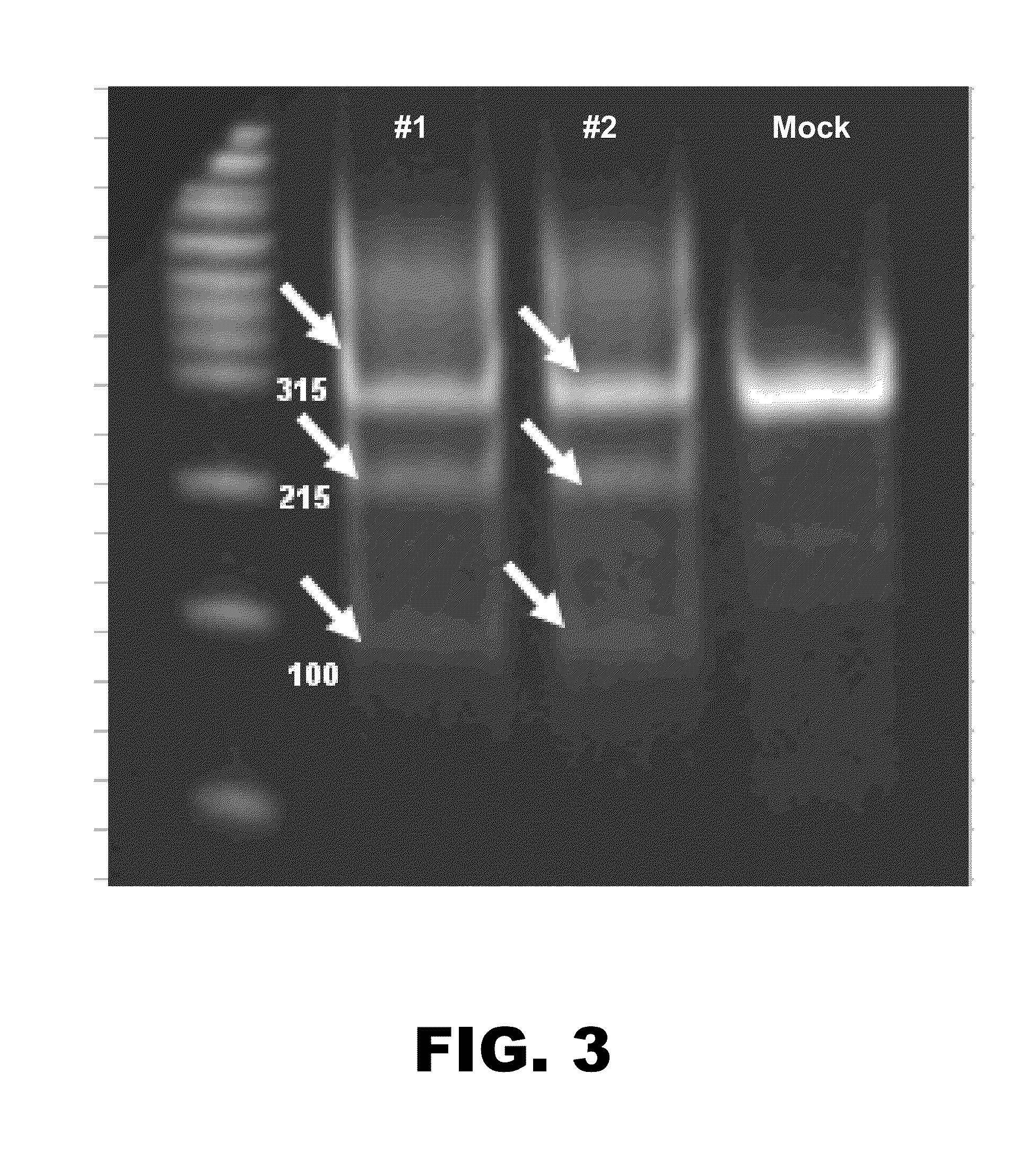Cells deficient in cmp-n-acetylneuraminic acid hydroxylase and/or glycoprotein alpha-1,3-galactosyltransferase
- Summary
- Abstract
- Description
- Claims
- Application Information
AI Technical Summary
Benefits of technology
Problems solved by technology
Method used
Image
Examples
example 1
CHO Cells Contain Ggta1 Gene
[0098]To confirm the presence of the Ggta1 gene in CHO K1 cells, primers were designed to amplify regions of exons 8 and 9 of the Ggta1 gene. DNA from murine myeloma NS0 and CHO K1 cells was PCR amplified using one pair of primers. A band of the expected size of about 300 by was detected in both NS0 and CHO cells. The PCR fragments isolated from CHO cells were sequenced and aligned with the mouse Ggta1 gene (UniProtKB / Swiss-Prot Accession No.: P23336). Sequence identity was approximately 85%.
[0099]Quantitative PCR was used to evaluate mRNA expression in CHO cells relative to mouse cells. After normalization using actin, a comparison of the threshold cycle (Ct) values between the mouse NS0 cells and the CHO cells suggested that Ggta1 expression was significantly lower in CHO cells that in NS0 cells.
example 2
Generation of CHO Cells Comprising an Inactivated Ggta1 Locus
[0100]A pair of ZFNs was designed to target a region within exon 9 of the Ggta1 gene in CHO cells. Ggta1 sequences were obtained from a proprietary transcriptome sequence and verified using RT-PCR. ZFNs targeting the gene were designed using a proprietary algorithm, and subsequently tested. In vitro transcription and mRNA poly-adenylation and capping were produced from ZFN plasmid DNA as described in CompoZr® Knockout Zinc Finger Nucleases (ZFN) product information. Briefly, plasmid ZFN DNA was linearized, and purified via phenol / chloroform DNA extraction. MessageMax™ T7 ARCA-Capped Message Transcription Kit (Cell Script Inc.) was used to cap the linearized DNA. A Poly(A) Polymerase Tailing Kit (EpiCenter) was used to add a poly(A) tail. ZFN mRNA was purified using the MEGAclear™ kit (Ambion).
[0101]The CHOZN (gs − / −) cell line expressing recombinant anti-Rabies human IgG was used. All cell culture media, supplements and ot...
example 3
Single Cell Cloning and Genotyping of Ggta1 Knockout Cells
[0103]Upon confirmation of ZFN activity using the Cell assay, the Ggta1 ZFN transfected cells were single-cell cloned using limiting dilution. For this, cells were plated at 0.5 cell / well using a mixture of 80% CHO serum-free cloning media, 20% conditioned media, and 4 mM L-glutamine. Clonality and growth were microscopically verified on days 7 and 14 post plating, respectively. Clones with growth were expanded and genotyped by PCR and sequencing. One Ggta1 (− / −) and four Ggta1 (+ / −) clones were isolated that bore deletions of various lengths, as detailed below in Table 1. All of the cell lines exhibited similar growth characteristics as the parental cell line from which they were derived.
TABLE 1Genotypic characterization of Ggta1 knockout clonesClone IDAllele 1Allele 2GenotypeBF1014 bp deletionNot detectedBiallelic knockoutCG3 7 bp deletionwildtypeHeterozygoteDA4 2 bp deletionwildtypeHeterozygoteDC711 bp deletionwildtypeHete...
PUM
| Property | Measurement | Unit |
|---|---|---|
| Solubility (mass) | aaaaa | aaaaa |
| Content | aaaaa | aaaaa |
| Immunogenicity | aaaaa | aaaaa |
Abstract
Description
Claims
Application Information
 Login to View More
Login to View More - R&D
- Intellectual Property
- Life Sciences
- Materials
- Tech Scout
- Unparalleled Data Quality
- Higher Quality Content
- 60% Fewer Hallucinations
Browse by: Latest US Patents, China's latest patents, Technical Efficacy Thesaurus, Application Domain, Technology Topic, Popular Technical Reports.
© 2025 PatSnap. All rights reserved.Legal|Privacy policy|Modern Slavery Act Transparency Statement|Sitemap|About US| Contact US: help@patsnap.com


